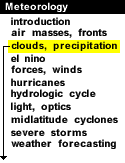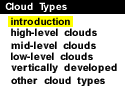
|
Clouds are classified into a system that uses Latin words to describe the appearance of clouds as seen by an observer on the ground. The table below summarizes the four principal components of this classification system (Ahrens, 1994).
| Latin Root | Translation | Example | ||
| cumulus
stratus cirrus nimbus | heap
layer curl of hair rain | fair weather cumulus
altostratus cirrus cumulonimbus |
Further classification identifies clouds by height of cloud base. For example, cloud names containing the prefix "cirr-", as in cirrus clouds, are located at high levels while cloud names with the prefix "alto-", as in altostratus, are found at middle levels. This module introduces several cloud groups. The first three groups are identified based upon their height above the ground. The fourth group consists of vertically developed clouds, while the final group consists of a collection of miscellaneous cloud types.
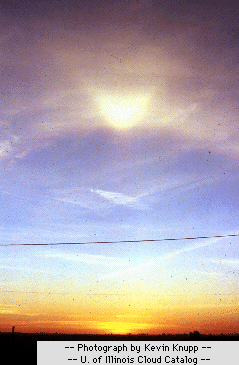
Photograph by: Knupp |
High-Level Clouds
High-level clouds form above 20,000 feet (6,000 meters) and since the temperatures are so cold at such high elevations, these clouds are primarily composed of ice crystals. High-level clouds are typically thin and white in appearance, but can appear in a magnificent array of colors when the sun is low on the horizon. |

Photograph by: Holle |
Mid-Level Clouds
The bases of mid-level clouds typically appear between 6,500 to 20,000 feet (2,000 to 6,000 meters). Because of their lower altitudes, they are composed primarily of water droplets, however, they can also be composed of ice crystals when temperatures are cold enough. |
Low-level Clouds
Low clouds are of mostly composed of water droplets since their bases
generally lie below 6,500 feet
(2,000 meters). However, when temperatures are
cold enough, these clouds may also contain
ice particles and snow.
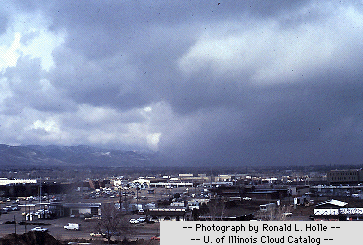
Photograph by: Holle
Vertically Developed Clouds
Probably the most familiar of the classified clouds is the cumulus
cloud.
Generated most commonly through either
thermal convection
or frontal lifting,
these clouds can grow to heights in
excess of 39,000 feet (12,000 meters), releasing incredible amounts of energy
through the condensation
of water vapor within the cloud itself.
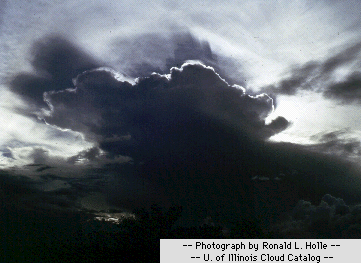
Photograph by: Holle
Other Cloud Types
Finally, we will introduce a collection of miscellaneous cloud types
which do not fit into the previous four groups.
|
Classifications
Last Update: 07/09/97 |
High-Level Clouds
Cloud types include: cirrus and cirrostratus.
Mid-Level Clouds
Low-Level Clouds
Clouds with Vertical Development
Other Cloud Types
|

Development |
|

High-Level Clouds |


